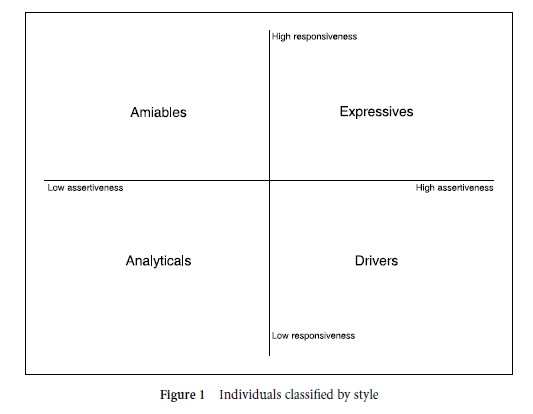Socio-communicative style is a presentational communication trait. Teachers with a particular style should communicate in a consistent manner, demonstrating that style over time and in different situations. The constructs of teacher socio-communicative style (how a teacher would perceive himself or herself) and teacher socio-communicative orientation (how students would view the teacher) are based on earlier research into psychological androgyny, social style, personal style, and communicator style. Measurement of teacher socio-communicative style is based on teachers’ levels of assertiveness and responsiveness.
People who are assertive communicators are strong in their interaction management skills; they are able to initiate, maintain, and terminate conversations skillfully. Assertive people are also able to speak up for what is rightfully theirs and are focused on being successful and achieving their goals. Being competitive, dominant, forceful, and independent are characteristic of being assertive.
Assertive teachers would have control of their classrooms. Others would perceive these teachers as being the leaders of the classroom. Although there may be plenty of student discussion and participation in their classrooms, assertive teachers would make sure the class focused on the task and accomplished the objectives for the class period. Assertive teachers would stand up for their own rights, as well as for the rights of their students.

People who are responsive are other-oriented and considerate of others’ feelings. Responsive individuals listen to others and show a general concern for the success of others. Being helpful, compassionate, friendly, and sincere are characteristic of being responsive.
Responsive teachers would be sensitive to the educational and personal needs of their students. These teachers would be viewed as being student oriented or student centered. Responsive teachers would be verbally and nonverbally immediate. Students would describe these teachers as caring and approachable.
Merrill and Reid (1981) classified individuals into one of four styles based on their assertiveness and responsiveness (Fig. 1). Amiables are those high in responsiveness but low in assertiveness; expressives are high in both responsiveness and assertiveness; analyticals are low in responsiveness and assertiveness; and drivers are low in responsiveness but high in assertiveness. While the expressive style would appear to be more appealing because of being high in both responsiveness and assertiveness, there are positive and negative characteristics for possessing – or being able to communicate – only in one style. To be successful, people need to be flexible and adapt their style to the situation.
In instructional research involving socio-communicative style – following the lead of Richmond and McCroskey (1990) – the four styles are often relabeled. Amiable becomes submissive, expressive becomes competent, analytical becomes noncompetent, and driver becomes aggressive.
Research has shown that, in the classroom, both teacher assertiveness and teacher responsiveness are positively correlated with nonverbal immediacy. Students view assertive and responsive teachers (i.e., competents) as being more trustworthy and credible. Teachers perceived as having the aggressive style are perceived as being low in character. When teachers are perceived as having the noncompetent style (neither assertive nor responsive), students perceive them as being low in competence and caring, and also express less situational motivation.
Additionally, teachers who engage in both assertiveness and responsiveness are perceived to be more argumentative, whereas instructors low in those constructs (i.e., noncompetents) are viewed as more verbally aggressive. Teachers who are argumentative would focus on the content of a disagreement when discussing controversial issues with others whereas teachers who are verbally aggressive would be more likely to make personal attacks on those with whom they disagree. Students also claim that their competent teachers are clearer and that they learn more from competent teachers. Students are more willing to communicate with their teachers inside the classroom, as well as outside the classroom, when they believe their teachers are assertive and responsive.
Although research has demonstrated the value of teachers being both assertive and responsive, researchers have also noted the need to be flexible. There might be situations where a teacher does not want to be assertive, and where assertive communication could actually prohibit the teacher from being successful. The truly competent teacher would have the ability to be assertive and responsive, as well as the knowledge and willingness to be flexible, communicating appropriately and effectively in a given situation.
References:
- Bem, S. L. (1974). The measurement of psychological androgyny. Journal of Consulting and Clinical Psychology, 42, 155–162.
- Lashbrook, W. B. (1974). Toward the measurement and processing of the social style profile. Eden Prairie, MN: Wilson.
- Martin, M. M., Chesebro, J. L., & Mottet, T. P. (1998). Students’ perceptions of instructors’ sociocommunicative style and the influence on instructor credibility and motivation. Communication Research Reports, 14, 431–440.
- Merrill, D. W., & Reid, R. H. (1981). Personal styles and effective performance. Radnor, PA: Chilton.
- Richmond, V. P. (2002). Socio-communicative style and orientation in instruction: Giving good communication and receiving good communication. In J. L. Chesebro & J. C. McCroskey (eds.), Communication for teachers. Boston, MA: Allyn and Bacon, pp. 104–115.
- Richmond, V. P., & Martin, M. M. (1998). Sociocommunicative style and sociocommunicative orientation. In J. C. McCroskey, J. A. Daly, M. M. Martin, & M. J. Beatty (eds.), Communication and personality: Trait perspectives. Cresskill, NJ: Hampton Press, pp. 133–148.
- Richmond, V. P., & McCroskey, J. C. (1990). Reliability and separation of factors on the assertiveness–responsiveness measure. Psychological Reports, 67, 449– 450.
- Thomas, C. E., Richmond, V. P., & McCroskey, J. C. (1994). The association between immediacy and socio-communicative style. Communication Research Reports, 11, 107–115.
- Wanzer, M. B., & McCroskey, J. C. (1998). Teacher socio-communicative style as a correlate of student affect toward teacher and course material. Communication Education, 47, 43–52.
Back to Educational Communication.
